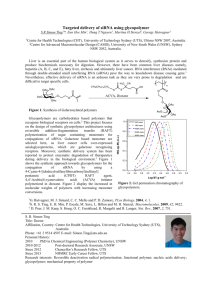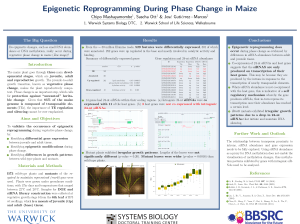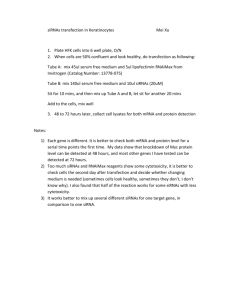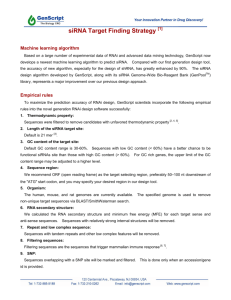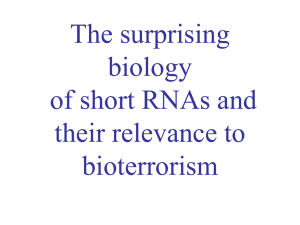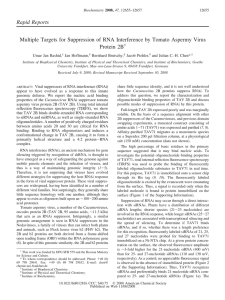jws-hep.21285.mtd
advertisement
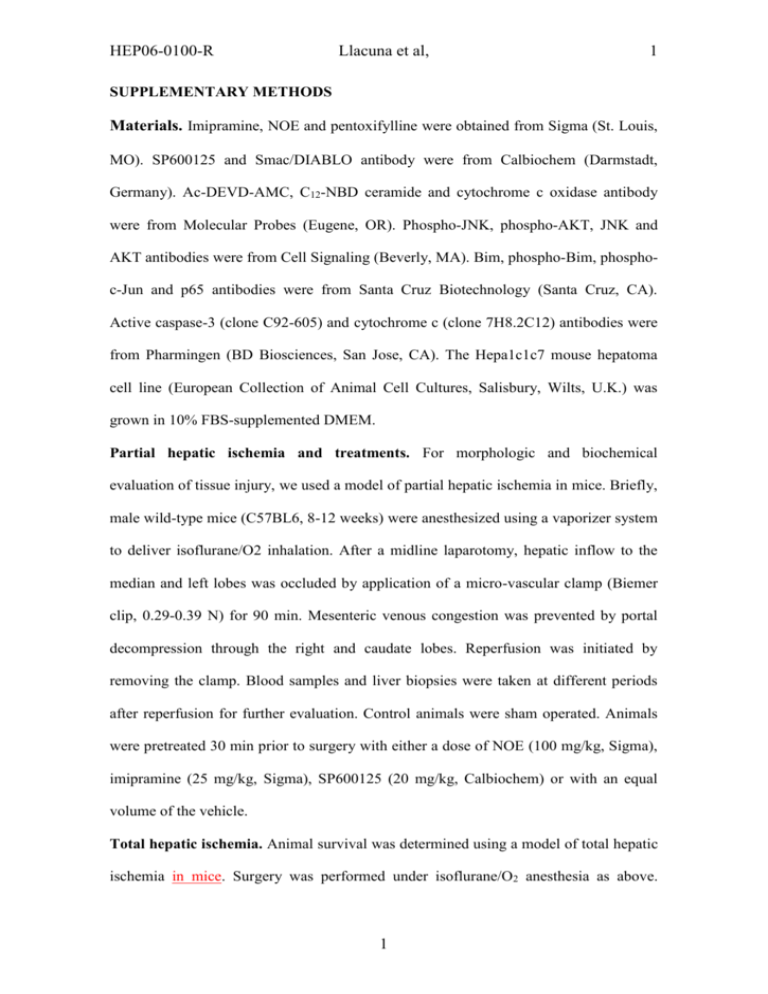
HEP06-0100-R Llacuna et al, 1 SUPPLEMENTARY METHODS Materials. Imipramine, NOE and pentoxifylline were obtained from Sigma (St. Louis, MO). SP600125 and Smac/DIABLO antibody were from Calbiochem (Darmstadt, Germany). Ac-DEVD-AMC, C12-NBD ceramide and cytochrome c oxidase antibody were from Molecular Probes (Eugene, OR). Phospho-JNK, phospho-AKT, JNK and AKT antibodies were from Cell Signaling (Beverly, MA). Bim, phospho-Bim, phosphoc-Jun and p65 antibodies were from Santa Cruz Biotechnology (Santa Cruz, CA). Active caspase-3 (clone C92-605) and cytochrome c (clone 7H8.2C12) antibodies were from Pharmingen (BD Biosciences, San Jose, CA). The Hepa1c1c7 mouse hepatoma cell line (European Collection of Animal Cell Cultures, Salisbury, Wilts, U.K.) was grown in 10% FBS-supplemented DMEM. Partial hepatic ischemia and treatments. For morphologic and biochemical evaluation of tissue injury, we used a model of partial hepatic ischemia in mice. Briefly, male wild-type mice (C57BL6, 8-12 weeks) were anesthesized using a vaporizer system to deliver isoflurane/O2 inhalation. After a midline laparotomy, hepatic inflow to the median and left lobes was occluded by application of a micro-vascular clamp (Biemer clip, 0.29-0.39 N) for 90 min. Mesenteric venous congestion was prevented by portal decompression through the right and caudate lobes. Reperfusion was initiated by removing the clamp. Blood samples and liver biopsies were taken at different periods after reperfusion for further evaluation. Control animals were sham operated. Animals were pretreated 30 min prior to surgery with either a dose of NOE (100 mg/kg, Sigma), imipramine (25 mg/kg, Sigma), SP600125 (20 mg/kg, Calbiochem) or with an equal volume of the vehicle. Total hepatic ischemia. Animal survival was determined using a model of total hepatic ischemia in mice. Surgery was performed under isoflurane/O2 anesthesia as above. 1 HEP06-0100-R Llacuna et al, 2 After a midline laparotomy, the portal triad was exposed and median and left liver lobes were occluded for 60 min with a vascular clamp, preserving the perfusion of the remaining liver and preventing mesenteric venous congestion during ischemia. Immediately after reperfusion, the non-ischemic lobes (right and caudate) were ligated with 3/0 sterile silk and resected leaving the ischemic lobes. Animals were monitored every 12 hours during one week, and survival was calculated using the Kaplan-Meier method. Liver histology and TUNEL. After reperfusion the liver was fixed and sections (5 µm) were stained with hematoxylin and eosin using standard methods. TUNEL staining was performed using a commercial kit (In Situ Cell Death Detection Kit, POD from Roche), examining the slides with a Zeiss Axioplan microscope equipped with a Nikon DXM1200F digital camera. Serum ALT levels were measured by the Centro de Diagnostico Medico (Hospital Clinic, Barcelona). In vitro siRNA transfection and in vivo treatment. The program siRNA target finder (Ambion), which follows the guidelines described by Elbashir et al (1), was used to design specific siRNAs to downregulate ASMase. In addition, target sequences with more than 16-17 contiguous base pairs of homology to other coding sequence were eliminated from consideration, whereas appropriate controls to ensure the validity of the data were included following design recommendations (2). Three siRNA sequences targeting human ASMase mRNA (Gene BankTM Z14252), identified at positions relative to the start codon: 271-291 (AAAGTCTTATTCACTGCTCTC) ASMase siRNA-1. 517-537 (AACATAGCACCACTAGATGTG) ASMase siRNA-2. 1491-1511 (AATAGATGGAAACTACCCCGG) ASMase siRNA-3. 2 HEP06-0100-R Llacuna et al, 3 In addition, a negative control siRNA, without homology to any other gene, was designed scrambling the nucleotide sequence of the ASMase siRNA-1, the siRNA with higher efficacy to silence ASMase mRNA (not shown). The siRNAs were generated following manufacturer´s recommendations with a transcription-based kit from Ambion (SilencerTM siRNA construction kit), For in vivo experiments, chemically synthesized siRNAs (Curevac, Tübingen, Germany) were delivered into mice using the hydrodynamic transfection method by i.v. injecting 1 nmols of scrambled or ASMase siRNAs in 1 ml of PBS into the tail vein 24 and 48 hours before surgery. This method, which has been proved effective to silence liver proteins in vivo, delivers siRNAs to most of the mouse parenchymal cells (6070%). To discard interferon response in siRNA-treated animals, IL-12 serum levels were measured after siRNA injection using an ELISA commercial kit (PeproTech EC, London, UK). Poly I:C (Amersham, 2.5 mg/kg b.w.) was injected as a positive control of IL-12 induction. Real time PCR. Total RNA was isolated from mouse liver samples with the TRIzol reagent (Invitrogen, Carlsbad, CA). Real-time PCR was performed using the iScript™ One-Step RT-PCR Kit with SYBR® Green (Bio-Rad, Hercules, CA) following the manufacturer instructions. Threshold (CT) values for each mRNA were subtracted from that of GAPDH mRNA, averaged and converted from log-linear to linear term. The primer sequences used for GAPDH (Gene BankTM accession number M23599) and ASMase (Gene BankTM accession number Z14252) amplification were as follows: ASMase forward 5’- GTCAGCCGTCCATCTCTTTGA-3’; ASMase reverse 5’-GGTCCCAGTGTAGATCAGTAA-3’; GAPDH forward 5’-CGACCCCTTCATTGACCTCAA-3’; GAPDH reverse 5’-CCTTCTCCATGGTGGTGAAGA-3’). 3 HEP06-0100-R Llacuna et al, 4 SUPPLEMENTARY REFERENCES 1. Elbashir SM, Harborth J, Lendeckel W, Yalcin A, Weber K, Tuschl T. Duplexes of 21-nucleotide RNAs mediate RNA interference in cultured mammalian cells. Nature 2001;411:494-498. 2. Editorial. Whitter RNAi? Nat Cell Biol 2003;5:489-490. 4
